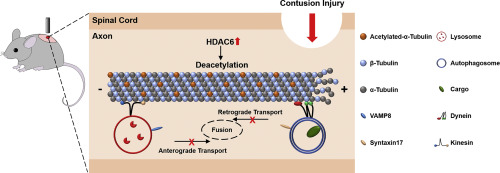当前位置:
X-MOL 学术
›
Exp. Neurol.
›
论文详情
Our official English website, www.x-mol.net, welcomes your
feedback! (Note: you will need to create a separate account there.)
Histone deacetylase 6 inhibition restores autophagic flux to promote functional recovery after spinal cord injury.
Experimental Neurology ( IF 4.6 ) Pub Date : 2019-11-30 , DOI: 10.1016/j.expneurol.2019.113138 Zhilong Zheng 1 , Yajiao Zhou 1 , Luxia Ye 1 , Qi Lu 1 , Kairui Zhang 1 , Jing Zhang 1 , Lin Xie 1 , Yanqing Wu 2 , Ke Xu 2 , Hongyu Zhang 1 , Jian Xiao 1
Experimental Neurology ( IF 4.6 ) Pub Date : 2019-11-30 , DOI: 10.1016/j.expneurol.2019.113138 Zhilong Zheng 1 , Yajiao Zhou 1 , Luxia Ye 1 , Qi Lu 1 , Kairui Zhang 1 , Jing Zhang 1 , Lin Xie 1 , Yanqing Wu 2 , Ke Xu 2 , Hongyu Zhang 1 , Jian Xiao 1
Affiliation

|
After spinal cord injury (SCI), the inhibitory molecules derived from scars at the lesion sites and the limited regenerative capacity of neuronal axons pose difficulties for the recovery after SCI. Remodeling of cytoskeleton structures including microtubule assembly and tubulin post-translational modification are widely accepted to play a crucial role in initiation of growth cone and regrowth of injured axon. Although increasing studies have focused on the association between tubulin acetylation and autophagy due to the role of tubulin acetylation in organelles and substances transport, there are no studies exploring the effect of tubulin acetylation on autophagy after spinal cord injury (SCI). Here, we found that histone deacetylase 6 (HDAC6) was significantly up-regulated after SCI, while inhibition of HDAC6 by Tubastatin A induced functional recovery after SCI. In view of enzyme-dependent and -independent mechanisms of HDAC6 to adjust diverse cellular processes, such as autophagy, the ubiquitin proteasome system and post-translational modification of tubulin, we mainly focused on the significance of HDAC6 in axonal regeneration and autophagy after SCI. Western blotting, Co-immunoprecipitation and immunofluorescence staining were conducted to showed that Tubastatin A treatment in nocodazole-treated cells and mice suffering from SCI prompted acetylation and stabilization of microtubules and thus restored transport function, which may contribute to restored autophagic flux and increased axonal length. Whereas inhibition of degradation of autolysosomes by bafilomycin A1 (Baf-A1) reversed functional recovery caused by Tubastatin A, revealing the association between tubulin acetylation and autophagy, which supports HDAC6 inhibition as a potential target for SCI treatment.
中文翻译:

抑制组蛋白脱乙酰基酶6可恢复自噬通量,以促进脊髓损伤后的功能恢复。
脊髓损伤(SCI)后,病变部位的疤痕来源的抑制分子和神经元轴突的再生能力有限,给SCI术后的恢复带来了困难。细胞骨架结构的重塑,包括微管组装和微管蛋白翻译后修饰,已被广泛接受,在受伤的轴突生长锥和再生长中起着至关重要的作用。尽管由于微管蛋白乙酰化在细胞器和物质运输中的作用,越来越多的研究集中在微管蛋白乙酰化和自噬之间的关联,但尚无研究探讨微管蛋白乙酰化对脊髓损伤(SCI)后自噬的影响。在这里,我们发现SCI后组蛋白脱乙酰基酶6(HDAC6)明显上调,Tubastatin A抑制HDAC6会导致SCI后功能恢复。鉴于HDAC6的酶依赖性和非依赖性机制可调节多种细胞过程,例如自噬,泛素蛋白酶体系统和微管蛋白的翻译后修饰,我们主要关注HDAC6在SCI后在轴突再生和自噬中的意义。进行了Western印迹,免疫共沉淀和免疫荧光染色,结果表明,在诺卡达唑处理的患有SCI的细胞和小鼠中,Tubastatin A处理促进了微管的乙酰化和稳定,从而恢复了运输功能,这可能有助于恢复自噬通量和增加轴突长度。 。
更新日期:2019-11-30
中文翻译:

抑制组蛋白脱乙酰基酶6可恢复自噬通量,以促进脊髓损伤后的功能恢复。
脊髓损伤(SCI)后,病变部位的疤痕来源的抑制分子和神经元轴突的再生能力有限,给SCI术后的恢复带来了困难。细胞骨架结构的重塑,包括微管组装和微管蛋白翻译后修饰,已被广泛接受,在受伤的轴突生长锥和再生长中起着至关重要的作用。尽管由于微管蛋白乙酰化在细胞器和物质运输中的作用,越来越多的研究集中在微管蛋白乙酰化和自噬之间的关联,但尚无研究探讨微管蛋白乙酰化对脊髓损伤(SCI)后自噬的影响。在这里,我们发现SCI后组蛋白脱乙酰基酶6(HDAC6)明显上调,Tubastatin A抑制HDAC6会导致SCI后功能恢复。鉴于HDAC6的酶依赖性和非依赖性机制可调节多种细胞过程,例如自噬,泛素蛋白酶体系统和微管蛋白的翻译后修饰,我们主要关注HDAC6在SCI后在轴突再生和自噬中的意义。进行了Western印迹,免疫共沉淀和免疫荧光染色,结果表明,在诺卡达唑处理的患有SCI的细胞和小鼠中,Tubastatin A处理促进了微管的乙酰化和稳定,从而恢复了运输功能,这可能有助于恢复自噬通量和增加轴突长度。 。











































 京公网安备 11010802027423号
京公网安备 11010802027423号